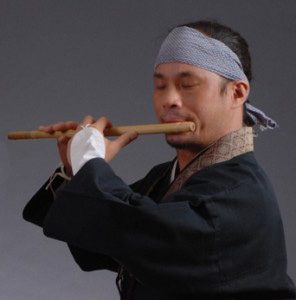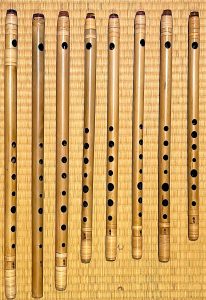The shinobue (kanji:篠笛); also called takebue (kanji: 竹笛) and fue (kanji: 笛) (in the context of Japanese traditional arts) is a Japanese transverse flute or yoko-bue that has a high-pitched sound. It is found in hayashi and nagauta ensembles, and plays important roles in noh and kabuki theatre music. It is heard in Shinto music such as kagura-den and in traditional Japanese folk songs. There are two styles: uta (song) and hayashi (festival). The uta is properly tuned to the Western scale, and can be played in ensembles or as a solo instrument. The hayashi is not tuned to a tempered scale, as it is simply a piece of hollow bamboo with holes cut into it. It emits a very high-pitched sound, and is appropriate for the festival/folk music of Japan. Both shinobue flutes and the noh-kan play a very important role in the Japanese theater.
Adapted from Wikipedia. (http://en.wikipedia.org/wiki/Shinobue)
Ryūzen Shinobue
In addition to crafting fine jinashi shakuhachi, Alcvin also applies his mastery of bamboo to creating shinobue bamboo flutes. He puts his heart and soul into every step finishing each fue with a tip of his signature Chiapas amber. With a focused passion for bamboo, he has been creating hand-made instruments for over 20 years. Alcvin’s love of spreading the bamboo sounds motivates him to create the best flutes he can. 
Ryuzen Shinobue Samples on Bamboo-In Tube
For info about purchasing Alcvin’s shinobue click here.


